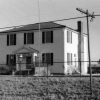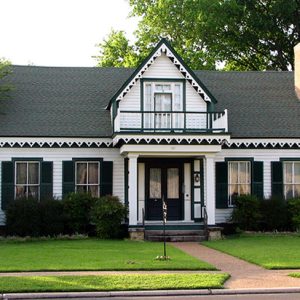calsfoundation@cals.org
Garrott House
The Garrott House is the oldest surviving structure in Batesville (Independence County) and the first Batesville structure listed on the National Register of Historic Places (1971). The first house in Batesville’s School Addition, it was built in 1842 by Independence County pioneer George Case, who moved to Batesville from Ohio in 1837. A carpenter and cabinetmaker, Case built the house for his wife’s sister and her husband, Eliza (Ridgeway) and Robert Williams, who were also from Ohio.
The house is of braced frame construction, its inner structure composed of squared logs mortised and pegged together at the base and top of each wall, each corner being “braced” by a diagonal log also mortised and pegged into the logs laid horizontally and vertically. In form, it is story-and-a-half Georgian: downstairs, four rooms flank a central hall and stairway; the upstairs has two rooms. Downstairs rooms measure 20 feet by 20 feet, upstairs 16 feet by 20 feet.
In 1853, after Williams’s death and his family’s move to California, Case took possession of the house; he later died during the Civil War. After the war, his daughter Mary Catherine and her husband, William Maxfield, a merchant and son of Batesville pioneers Uriah and Leah Maxfield, moved in. There they reared four daughters—Eula (Garrott), Nettie (Coffin), Ernestine (Guthrie), and Kate (Moore)—and took in William’s niece May Wilson, daughter of his sister Lucretia, who had died.
In the 1880s, the Maxfields modernized the house, giving it its present form by replacing the kitchen that had stood in the side yard with a new stone kitchen and flanking porches attached to the rear of the original structure. They also added a front gable at the center of the roof to accommodate a small new bedroom upstairs, along with Victorian details such as the faux marble fireplaces, window cornices, and the eight-foot doors that are still in the house.
Maxfield died in 1896, and his wife died in 1940. In 1944, the Maxfields’ daughter and son-in-law, Eula and the Reverend Ernest Perry Jackson (E. P. J.) Garrott, returned to Batesville when Garrott became pastor of the First Baptist Church. For the next twenty years, the Garrott House functioned as the parsonage.
Rev. Garrott died in 1962, and Eula Maxfield Garrott died in 1967. The family sold the house to Terrell and Diane Tebbetts in 1990. The Tebbettses restored the house in consultation with Little Rock (Pulaski County) architect Charles Witsell.
For additional information:
Britton, Nancy, ed. Independence Pioneers. Vol. 1. Batesville, AR: The Batesville Guard, 1986.
Britton, Nancy, and Diane Tebbetts. “Garrott House.” Independence County Chronicle 20 (January 1979): 20.
Britton, Nancy, et al. A Guidebook to Historic Homes of Batesville, Arkansas. Batesville, AR: Batesville Preservation Association, 1994.
“Garrott House.” National Register of Historic Places nomination form. On file at Arkansas Historic Preservation Program, Little Rock, Arkansas.
Terrell Tebbetts
Batesville, Arkansas
 Architectural Styles
Architectural Styles Garrott House
Garrott House 




Ive had such fun reading about our family house and swapping memories with my brother. Our father was William Maxfield Garrott, son of E. P. J. and Eula Maxfield Garrott. As we lived in Japan, we didnt get to Batesville except when we were on furloughs, but we have very vivid memories. I havent visited in Batesville since the summer of 1979, but am anxious to do so.